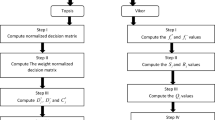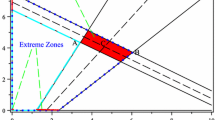Abstract
Rapid urbanization and population growth have resulted in worldwide serious water shortage and environmental deterioration. It is then essential for efficient and feasible allocation of scarce water and environment resources to the competing users. Due to inherent uncertainties, decision making for resources allocation is vulnerable to failure. The scheme feasibility can be evaluated by reliability, representing the failure probability. A progressive reliability-oriented multi-objective (PROMO) optimal decision-making procedure is proposed in this study to deal with problems with numerous reliability objectives. Dimensionality of the objectives is reduced by a top-down hierarchical reliability analysis (HRA) process combining optimization with evaluation. Pareto solutions of the reformulated model, representing alternative schemes non-dominated with each other, are generated by a metalmodel-based optimization algorithm. Evaluation and identification of Pareto solutions are conducted by multi-criteria decision analysis (MCDA). The PROMO procedure is demonstrated for a case study on industrial structure transformation under strict constraints of water resources and total environmental emissions amounts in Guangzhou City, South China. The Pareto front reveals tradeoffs between economic returns of the industries and system reliability. For different reliability preference scenarios, the Pareto solutions are ranked and the top-rated one was recommended for implementation. The model results indicate that the PROMO procedure is effective for model solving and scheme selection of uncertainty-based multi-objective decision making.



Similar content being viewed by others
References
Andreu J, Capilla J, Sanchís E (1996) AQUATOOL, a generalized decision-support system for water-resources planning and operational management. J Hydrol 177:269–291. doi:10.1016/0022-1694(95)02963-x
Askew AJ (1974) Chance-constrained dynamic programing and the optimization of water resource systems. Water Resour Res 10:1099
Behzadian K, Kapelan Z, Savic D, Ardeshir A (2009) Stochastic sampling design using a multi-objective genetic algorithm and adaptive neural networks. Environ Model Softw 24:530–541. doi:10.1016/j.envsoft.2008.09.013
Bes C, Sethi S (1989) Solution of a class of stochastic linear-convex control problems using deterministic equivalents. J Optimiz Theory App 62:17–27. doi:10.1007/BF00939627, Kluwer Academic Publishers-Plenum Publishers
Binder K (1986) Introduction: theory and technical aspects of Monte Carlo simulations. In: Binder PDK (ed) Monte Carlo methods in statistical physics. Topics in current physics. Springer, Berlin, pp 1–45
Blanning RW (1975) The construction and implementation of metamodels. Simulation 24:177–184. doi:10.1177/003754977502400606
Bonissone PP, Subbu R, Lizzi J (2009) Multicriteria decision making (MCDM): a framework for research and applications. Comput Intelligence Magazine, IEEE 4:48–61
Brockhoff D, Brockhoff D, Zitzler E, Zitzler E (2007) Improving hypervolume-based multiobjective evolutionary algorithms by using objective reduction methods. IEEE. doi:10.1109/cec.2007.4424730
Charnes A, Cooper WW (1959) Chance-constrained programming. Manage Sci 6:73–79. doi:10.1287/mnsc.6.1.73
China State Council (2011) 12th Five-Year Plan for National Economic and Social Development (FYP) (2011–2015). http://www.gov.cn/2011lh/content_1825838.htm
Coello CAC (1999) A comprehensive survey of evolutionary-based multiobjective optimization techniques. Knowl Inf Syst 1:269–308
Deb K, Goel T (2001) Controlled elitist non-dominated sorting genetic algorithms for better convergence. In: Evolutionary multi-criterion optimization, vol 1993. Springer, Berlin, pp 67–81
Deng YX, Zheng BH, Fu G, Lei K, Li ZC (2010) Study on the total water pollutant load allocation in the Changjiang (Yangtze River) Estuary and adjacent seawater area. Estuar Coast Shelf Sci 86:331–336. doi:10.1016/j.ecss.2009.10.024
Dong F, Liu Y, Su H, Zou R, Guo H (2015) Reliability-oriented multi-objective optimal decision-making approach for uncertainty-based watershed load reduction. Sci Total Environ 515–516:39–48. doi:10.1016/j.scitotenv.2015.02.024
Driels MR, Shin YS (2004) Determining the number of iterations for Monte Carlo simulations of weapon effectiveness. Naval Postgraduate School, Monterey, CA, Technical report. 2015-06-11 15:02:00
Foley JA et al (2011) Solutions for a cultivated planet. Nature 478:337–342
Gu JJ, Guo P, Huang GH, Shen N (2013) Optimization of the industrial structure facing sustainable development in resource-based city subjected to water resources under uncertainty. Stoch Env Res Risk A 27:659–673. doi:10.1007/s00477-012-0630-9
Guangzhou Environmental Protection Bureau (2013) Environment statistical manual, Guangzhou, China. (in Chinese)
Guangzhou Municipal Government (2014) Outline of general development planning in Guangzhou (2013–2030), Guangzhou, China. (in Chinese)
Hagan MT, Menhaj MB (1994) Training feedforward networks with the Marquardt algorithm. IEEE Trans Neural Netw 5:989–993. doi:10.1109/72.329697
Hajiabadi R, Zarghami M (2014) Multi-objective reservoir operation with sediment flushing; case study of Sefidrud reservoir. Water Resour Manag 28:5357–5376
Huang Y, Luo J, Xia B (2013) Application of cleaner production as an important sustainable strategy in the ceramic tile plant - a case study in Guangzhou, China, vol 42. Elsevier B.V, p 113
Jaimes AL, Coello CAC, Chakraborty D (2008) Objective reduction using a feature selection technique. In: Proceedings of the 10th annual conference on Genetic and evolutionary computation, Atlanta, GA, USA. ACM, pp 673–680. doi:10.1145/1389095.1389228
Jia H, Yao H, Tang Y, Yu SL, Field R, Tafuri AN (2015) LID-BMPs planning for urban runoff control and the case study in China. J Environ Manage 149:65–76. doi:10.1016/j.jenvman.2014.10.003
Kasprzyk JR, Reed PM, Characklis GW, Kirsch BR (2012) Many-objective de Novo water supply portfolio planning under deep uncertainty. Environ Model Softw 34:87–104. doi:10.1016/j.envsoft.2011.04.003
Kermani BG, Schiffman SS, Nagle HT (2005) Performance of the Levenberg-Marquardt neural network training method in electronic nose applications. Sensor Actuat B-chem 110:13–22. doi:10.1016/j.snb.2005.01.008
Li CL, Zhou JZ, Ouyang S, Wang C, Liu Y (2015) Water resources optimal allocation based on large-scale reservoirs in the upper reaches of Yangtze River. Water Resour Manag 29:2171–2187
Morgan DR, Eheart JW, Valocchi AJ (1993) Aquifer remediation design under uncertainty using a new chance constrained programming technique. Water Resour Res 29:551–561. doi:10.1029/92wr02130
Obayashi S, Deb K, Poloni C, Hiroyasu T, Murata T, Saxena DK, Deb K (2007) Non-linear dimensionality reduction procedures for certain large-dimensional multi-objective optimization problems: employing correntropy and a novel maximum variance unfolding. In: evolutionary multi-criterion optimization, vol 4403. Lecture Notes in Computer Science; 4th International Conference, EMO 2007, Matsushima, Japan. Proceedings. Springer Berlin Heidelberg, pp 772–787
Pena-Haro S, Pulido-Velazquez M, Llopis-Albert C (2011) Stochastic hydro-economic modeling for optimal management of agricultural groundwater nitrate pollution under hydraulic conductivity uncertainty. Environ Model Softw 26:999–1008. doi:10.1016/j.envsoft.2011.02.010
Qin XS, Huang GH (2009) An inexact chance-constrained quadratic programming model for stream water quality management. Water Resour Manag 23:661–695. doi:10.1007/s11269-008-9294-0
Rodriguez HG, Popp J, Maringanti C, Chaubey I (2011) Selection and placement of best management practices used to reduce water quality degradation in Lincoln Lake watershed. Water Resour Res 47, W01507. doi:10.1029/2009wr008549
Saaty TL (2005) The analytic hierarchy and analytic network processes for the measurement of intangible criteria and for decision-making, vol 13. Int Series Oper Res Manag Sci 1:345–407
Santoso T, Ahmed S, Goetschalckx M, Shapiro A (2005) A stochastic programming approach for supply chain network design under uncertainty. Eur J Oper Res 167:96–115. doi:10.1016/j.ejor.2004.01.046
Yoon K, Hwang C-L (2007) Manufacturing plant location analysis by multiple attribute decision making: part I—single-plant strategy. Int J Prod Res 23:345–359. doi:10.1080/00207548508904712
Zarghami M, Safari N, Szidarovszky F, Islam S (2015) Nonlinear interval parameter programming combined with cooperative games: a tool for addressing uncertainty in water allocation using water diplomacy framework. Water Resour Manag 29:4285–4303
Zhang XH, Zhang HW, Chen B, Guo HC, Chen GQ, Zhao BA (2009) An inexact-stochastic dual water supply programming model. Commun Nonlinear Sci Numer Simul 14:301–309. doi:10.1016/j.cnsns.2007.05.027
Zhang K, Wei YL, Zeng EY (2013) A review of environmental and human exposure to persistent organic pollutants in the Pearl River Delta, South China. Sci Total Environ 463–464:1093–1110. doi:10.1016/j.scitotenv.2012.10.104
Acknowledgments
This paper was supported by the National Natural Science Foundation of China (No. 41222002), China National Water Pollution Control Program (2012ZX07503-002), the Research Fund for the Doctoral Program of Higher Education of China (20120001110056), and the Collaborative Innovation Center for Regional Environmental Quality.
Author information
Authors and Affiliations
Corresponding author
Electronic Supplementary Material
Below is the link to the electronic supplementary material.
ESM 1
(PDF 441 kb)
Rights and permissions
About this article
Cite this article
Dong, F., Liu, Y., Su, H. et al. Uncertainty-Based Multi-Objective Decision Making with Hierarchical Reliability Analysis Under Water Resources and Environmental Constraints. Water Resour Manage 30, 805–822 (2016). https://doi.org/10.1007/s11269-015-1192-7
Received:
Accepted:
Published:
Issue Date:
DOI: https://doi.org/10.1007/s11269-015-1192-7




